
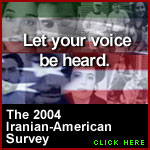 Behrouz
Bahmani Behrouz
Bahmani
September 9, 2004
iranian.com
As
the election draws nearer and nearer, Iranian-Americans realize
just how visible or invisible we are in the unfolding dialog
and debate in America.
After
several years writing for this esteemed publication, I'd like
to think that I have learned a thing or two about us. As I
explored my own knowledge and understanding of what kind of
an Iranian I am, I also gained from the wisdom of the readers
who set me straight whenever I drifted. I have formed an opinion
of sorts, that, as I have been told by my closest confidante,
occasionally goes "over the top".
But
one thing I have observed is that we are all too often, too
quiet, too polite, and seem to not care about our collective
plight. And we rarely (if ever?) move in a common direction.
If you disagree with this and can prove me wrong, then I am
glad to be so.
But,
exactly, who are we in America? And how do we show this to
America?
As
I asked these questions a year ago, I found to my great dismay
that the answer although somehwat and semi obvious to us within
the Iranian-American community, was not tangible. At least
not enough to really do anything with it.
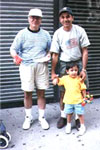 |
Family
Size ?
|
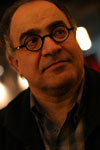 |
Education?
|
 |
Men
vs Women ?
|
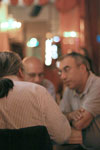 |
Average
Income?
|
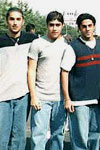 |
Average
Age?
|
It
was then I decided to go check out the US Census. Last taken
in 2000, this surely would be a source one would think would
offer the answers to our questions. One would think. And one
would be wrong. As it turned out the US Census not only did
not ask if a person was Iranian, but it did not offer a realistic
estimate either, never mind the important data that needs to
be behind it (Average age, Income, household size etc.). The
California state census, lumped Iranians under the "Hispanic
or Some Other" ethnic grouping. No, really, it actually
said "Some Other".
Shocked
and dismayed, I looked to the community to see if I could find
anything. The best I could find was a secondary research study
conducted by The
Iranian Studies Group at MIT, a group of real smart MIT
students, which I have to say did a pretty decent job, even
though it was based on the Census which in 2003, was now 3
years old. I contacted the MIT boys and they said they had
used what they could, and wished there was better data.
It
was the monthly mixer of the Iranian American Chamber of Commerce
(IACC)
in San Francisco, that put me in touch with Mike (Mehdi) Ghodoosian
(I now call him IranMike, get it?). Mehdi is a principal
at Universal
Responses Corp. and his firm conducts extensive online
marketing surveys for the likes of Microsoft, eBay, Siemens,
FannieMae, the province of Nova Scotia in Canada and on and
on.
As
he explained his company to me, a light suddenly went on in
my head. If I could convince him to let us use his survey system,
we could gather our own data! I just needed to find a way to
reach across America and connect with a focused group of Iranian-Americans.
How to do that?
I
frequently work on Marketing projects with a few community
groups like BAIVOTER, Persian
Center, IACC and PAYVAND in
the San Francisco Bay Area that I could get help from, I knew
my good friend Dr. Mohammad Ala from Iran
Heritage in Southern California would totally support it,
and then I realized I also had a good contact Trita Parsi at NIAC in
Washington DC, and I scoured my addressbook and re-found Neda
Nabavi at Shabeh
Jomeh in Chicago who could enlist her buddies at New York
and Seattle, and before you knew it, I had about 10 well respected
community groups lined up.
I
contacted each group through my primary contacts and started
to discuss the idea. We would launch an online survey to collect
and tabulate the various average temperatures of the Iranian
American community! It had never been done and the odds were
against it happening, and I hadn't even started to think about
the costs. But without flinching, everyone said it was a good
idea and supported it right from the start.

The
Money.
So
back to Mehdi, I went, hat in hand, hand over chest, I was
determined to play my most nokaretam, khakeh-patam, jooneh-Behrouz,
plea for the usual deep discount. It was a waste of time. As
soon as I told him about the response, he immediately offered
to conduct the survey for free. This amounted to a "gift" of
around $30,000-$40,000. Shocked, I somehow "negotiated" that
he should "at least let us cover your overhead costs!" This
amounted to $2,400. "I can get that easy!", or so
I thought.
I
have to stop and take a moment to express my sincerest gratitude
to Mehdi Ghodoosian, because without his help and generosity
this project would never have happened. His faith and trust
in someone he did not know, solely because we were both Iranian
was nothing short of inspiring. You are a jewel sir.
So
off to the community groups I went. I figured I could get 10
groups to pay $240 each to sponsor the project. A paltry sum
for most, this turned out to be a good strategy and everyone
pretty much sent in their check more or less on time. If I
had to do it over again, I would work on collecting the money
sooner, because it took a lot longer to get the checks than
I thought.
But
we started with the survey questions. I sent out a series of
starter questions to each group and asked them to review and
send back their feedback. As expected the feedback was overwhelming.
We
knew we were dealing with a timid community, and nothing like
this had ever been done before on this scale. We decided we
would NOT ask ALL of the possible questions, and ONLY ask SOME
of the questions we were all dying to know. The idea was to
plant a seed of success, to show it could be done, and to leave
something on the plate with which to encourage others to join.
Kind of a teaser.
 Another
issue that was extremely controversial was the issue of people's
privacy, and as we debated it back and forth, we ultimately
determined that for this first effort, we could not risk alienating
those who might be afraid and decided to make the survey completely
anonymous.
Another
issue that was extremely controversial was the issue of people's
privacy, and as we debated it back and forth, we ultimately
determined that for this first effort, we could not risk alienating
those who might be afraid and decided to make the survey completely
anonymous.
Another
issue was the question of accuracy and validity. I contacted
several American survey firms and discussed this at great length.
The consensus, was that although we were limited on exactness
and verification, the fact that we could focus the survey so
precisely on Iranian-Americans would far outweigh any sampling
error, and the study would still be considered highly accurate.
Another
issue was the question of the possible skewing of the results
because we were only using the internet for our survey. Once
again the experts assured me that the statistical difference
between the computer literate and computer illiterate was negligible
these days, even more so for Iranians, given their expected
high level of education. Meaning more Iranians than not have
access to a computer which essentially washes away the impact
of those that don't. Although I still have a problem believing
this, we had no choice but to accept this assumption, because
the funding requirements of a full-blown paper-based survey,
mailed to Iranian-American households (as if such a mailing
list is even available), or published in Iranian periodicals
and then the mail-box, fax back, data entry issues were simply
too far beyond our financial and logistical ability. We wanted
to, but the simple fact is that we couldn't afford to.
And
so here it is. In all it's glory.
We
give you your first ever 2004 Iranian-American Survey. If you
haven't already, take it now, becasue it will be closed on
Sept. 15th, and the final report of the findings will be published
on October 1, 2004.
Now
it's up to you to make us all proud.

|